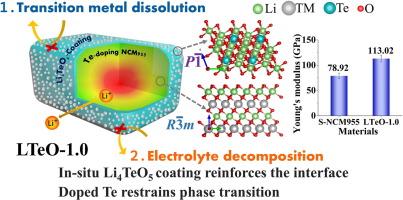通过元素梯度掺杂和界面改性提高单晶富镍阴极在高压下的结构稳定性
IF 13.1
1区 化学
Q1 Energy
引用次数: 0
摘要
单晶富镍阴极可为锂离子电池(LIB)提供高能量密度和容量保持率。然而,单晶富镍阴极在长时间的高电压循环过程中会出现严重的过渡金属溶解、不可逆相变和结构稳定性降低,这将极大地阻碍其实际应用。本文提出并开发了一种 Li4TeO5 表面涂层和块状 Te 梯度掺杂策略,以解决单晶富 Ni-LiNi0.90Co0.05Mn0.05O2 阴极(LTeO-1.0)的这些问题。研究发现,块体 Te6+ 梯度掺杂可形成稳固的 Te-O 键,有效抑制 H2-H3 相变并加固晶格框架,原位 Li4TeO5 涂层可作为保护层抑制寄生反应和晶粒破碎。此外,改性后的材料具有更高的杨氏模量,有利于在高压条件下保持显著的结构和电化学稳定性。特别是,LTeO-1.0 电极在 4.3 V 和 4.5 V 截断电压下循环 200 次后,Li+ 扩散动力学和热力学稳定性得到改善,容量保持率分别达到 95.83% 和 82.12%。因此,高效的双重改性策略必将有助于提高单晶富镍阴极的结构和电化学稳定性,并开发其在 LIB 中的应用。本文章由计算机程序翻译,如有差异,请以英文原文为准。

Improving structure stability of single-crystalline Ni-rich cathode at high voltage by element gradient doping and interfacial modification
Single-crystalline Ni-rich cathodes can provide high energy density and capacity retention rates for lithium-ion batteries (LIBs). However, single-crystalline Ni-rich cathodes experience severe transition metal dissolution, irreversible phase transitions, and reduced structural stability during prolonged cycling at high voltage, which will significantly hinder their practical application. Herein, a Li4TeO5 surface coating along with bulk Te-gradient doping strategy is proposed and developed to solve these issues for single-crystalline Ni-rich LiNi0.90Co0.05Mn0.05O2 cathode (LTeO-1.0). It has been found that the bulk Te6+ gradient doping can lead to the formation of robust Te–O bonds that effectively inhibit H2-H3 phase transformations and reinforce the lattice framework, and the in-situ Li4TeO5 coating layer can act as a protective layer that suppresses the parasitic reactions and grain fragmentation. Besides, the modified material exhibits a higher Young’s modulus, which will be conducive to maintaining significant structural and electrochemical stability under high-voltage conditions. Especially, the LTeO-1.0 electrode shows the improved Li+ diffusion kinetics and thermodynamic stability as well as high capacity retention of 95.83% and 82.12% after 200 cycles at the cut-off voltage of 4.3 and 4.5 V. Therefore, the efficacious dual-modification strategy will definitely contribute to enhancing the structural and electrochemical stability of single-crystalline Ni-rich cathodes and developing their application in LIBs.
求助全文
通过发布文献求助,成功后即可免费获取论文全文。
去求助
来源期刊

Journal of Energy Chemistry
CHEMISTRY, APPLIED-CHEMISTRY, PHYSICAL
CiteScore
19.10
自引率
8.40%
发文量
3631
审稿时长
15 days
期刊介绍:
The Journal of Energy Chemistry, the official publication of Science Press and the Dalian Institute of Chemical Physics, Chinese Academy of Sciences, serves as a platform for reporting creative research and innovative applications in energy chemistry. It mainly reports on creative researches and innovative applications of chemical conversions of fossil energy, carbon dioxide, electrochemical energy and hydrogen energy, as well as the conversions of biomass and solar energy related with chemical issues to promote academic exchanges in the field of energy chemistry and to accelerate the exploration, research and development of energy science and technologies.
This journal focuses on original research papers covering various topics within energy chemistry worldwide, including:
Optimized utilization of fossil energy
Hydrogen energy
Conversion and storage of electrochemical energy
Capture, storage, and chemical conversion of carbon dioxide
Materials and nanotechnologies for energy conversion and storage
Chemistry in biomass conversion
Chemistry in the utilization of solar energy
 求助内容:
求助内容: 应助结果提醒方式:
应助结果提醒方式:


